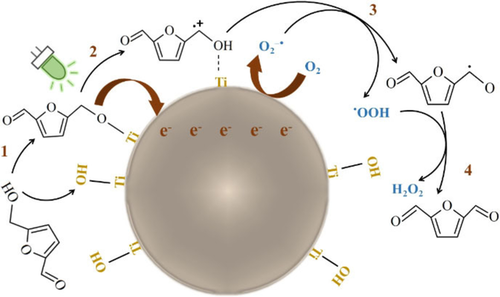Selective Oxidation of 5-Hydroxymethylfurfural to 2,5-Diformylfuran by Visible Light-Driven Photocatalysis over In Situ Substrate-Sensitized Titania
Ayesha Khan, Michael Goepel, Adam Kubas, Dariusz Łomot, Wojciech Lisowski, Dmytro Lisovytskiy, Ariadna Nowicka, Juan Carlos Colmenares, Roger Gläser
ChemSusChem 2021, 14, 1351–1362
Abstract
 Solar energy-driven processes for biomass valorization are priority for the growing industrialized society. To address this challenge, efficient visible light-active photocatalyst for the selective oxidation of biomass-derived platform chemical is highly desirable. Herein, selective oxidation of 5-hydroxymethylfurfural (HMF) to 2,5-diformylfuran (DFF) was achieved by visible light-driven photocatalysis over titania. Pristine titania is photocatalytically inactive under visible light, so an unconventional approach was employed for the visible light (λ=515 nm) sensitization of titania via a formation of a visible light-absorbing complex of HMF (substrate) on the titania surface. Surface-complexation of HMF on titania mediated ligand-to-metal charge transfer (LMCT) under visible light, which efficiently catalyzed the oxidation of HMF to DFF. A high DFF selectivity of 87 % was achieved with 59 % HMF conversion after 4 h of illumination. The apparent quantum yield obtained for DFF production was calculated to be 6.3 %. It was proposed that the dissociative interaction of hydroxyl groups of HMF and the titania surface is responsible for the surface-complex formation. When the hydroxyl groups of titania were modified via surface-fluorination or calcination the oxidation of HMF was inhibited under visible light, signifying that hydroxyl groups are decisive for photocatalytic activity.
Solar energy-driven processes for biomass valorization are priority for the growing industrialized society. To address this challenge, efficient visible light-active photocatalyst for the selective oxidation of biomass-derived platform chemical is highly desirable. Herein, selective oxidation of 5-hydroxymethylfurfural (HMF) to 2,5-diformylfuran (DFF) was achieved by visible light-driven photocatalysis over titania. Pristine titania is photocatalytically inactive under visible light, so an unconventional approach was employed for the visible light (λ=515 nm) sensitization of titania via a formation of a visible light-absorbing complex of HMF (substrate) on the titania surface. Surface-complexation of HMF on titania mediated ligand-to-metal charge transfer (LMCT) under visible light, which efficiently catalyzed the oxidation of HMF to DFF. A high DFF selectivity of 87 % was achieved with 59 % HMF conversion after 4 h of illumination. The apparent quantum yield obtained for DFF production was calculated to be 6.3 %. It was proposed that the dissociative interaction of hydroxyl groups of HMF and the titania surface is responsible for the surface-complex formation. When the hydroxyl groups of titania were modified via surface-fluorination or calcination the oxidation of HMF was inhibited under visible light, signifying that hydroxyl groups are decisive for photocatalytic activity.



